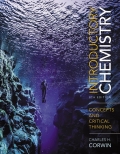
Concept explainers
Interpretation:
The grams of iron
Concept introduction:
Answer to Problem 34E
The grams of iron
Explanation of Solution
The reaction is given below.
In the reaction,
Therefore, the mole ratio is given below.
The mole ratio to obtain moles of
The molar mass of iron is
The molar mass of oxygen is
The molar mass of carbon is
Therefore, the molar mass of
The unit factor to calculate grams of
The volume of
At STP
Therefore, the number of moles of
The formula to calculate the mass of
Substitute the value of moles of
Therefore, the grams of iron
The grams of iron
Want to see more full solutions like this?
Chapter 9 Solutions
EBK INTRODUCTORY CHEMISTRY
- If an electric current is passed through molten sodium chloride, elemental chlorine gas is generated as the sodium chloride is decomposed. :math>2NaCl(1)2Na(s)+Cl2(g) at volume of chlorine gas measured at 767 mm Hg at 25 °C would be generated by complete decomposition of 1.25 g of NaCl?arrow_forwardThe nitrogen content of organic compounds can be determined by the Dumas method. The compound in question is first reacted by passage over hot CuO(s): CompoundCuO(s)HotN2(g)+CO2(g)+H2O(g) The product gas is then passed through a concentrated solution of KOH to remove the CO2. After passage through the KOH solution, the gas contains N2 and is saturated with water vapor. In a given experiment a 0.253-g sample of a compound produced 31.8 mL N2 saturated with water vapor at 25C and 726 torr. What is the mass percent of nitrogen in the compound? (The vapor pressure of water at 25C is 23.8 torr.)arrow_forwardHydrogen gas is bubbled into a solution of barium hydroxide that has sulfur in it. The equation for the reaction that takes place is H2(g)+S(s)+2OH(aq) S2(aq)+2H2OWhat volume of 0.349 M Ba(OH)2 is required to react completely with 3.00 g of sulfur?arrow_forward
 Chemistry: Principles and ReactionsChemistryISBN:9781305079373Author:William L. Masterton, Cecile N. HurleyPublisher:Cengage LearningChemistry: Matter and ChangeChemistryISBN:9780078746376Author:Dinah Zike, Laurel Dingrando, Nicholas Hainen, Cheryl WistromPublisher:Glencoe/McGraw-Hill School Pub Co
Chemistry: Principles and ReactionsChemistryISBN:9781305079373Author:William L. Masterton, Cecile N. HurleyPublisher:Cengage LearningChemistry: Matter and ChangeChemistryISBN:9780078746376Author:Dinah Zike, Laurel Dingrando, Nicholas Hainen, Cheryl WistromPublisher:Glencoe/McGraw-Hill School Pub Co Introductory Chemistry: A FoundationChemistryISBN:9781337399425Author:Steven S. Zumdahl, Donald J. DeCostePublisher:Cengage Learning
Introductory Chemistry: A FoundationChemistryISBN:9781337399425Author:Steven S. Zumdahl, Donald J. DeCostePublisher:Cengage Learning Chemistry & Chemical ReactivityChemistryISBN:9781337399074Author:John C. Kotz, Paul M. Treichel, John Townsend, David TreichelPublisher:Cengage Learning
Chemistry & Chemical ReactivityChemistryISBN:9781337399074Author:John C. Kotz, Paul M. Treichel, John Townsend, David TreichelPublisher:Cengage Learning Chemistry & Chemical ReactivityChemistryISBN:9781133949640Author:John C. Kotz, Paul M. Treichel, John Townsend, David TreichelPublisher:Cengage Learning
Chemistry & Chemical ReactivityChemistryISBN:9781133949640Author:John C. Kotz, Paul M. Treichel, John Townsend, David TreichelPublisher:Cengage Learning Introductory Chemistry: An Active Learning Approa...ChemistryISBN:9781305079250Author:Mark S. Cracolice, Ed PetersPublisher:Cengage Learning
Introductory Chemistry: An Active Learning Approa...ChemistryISBN:9781305079250Author:Mark S. Cracolice, Ed PetersPublisher:Cengage Learning





